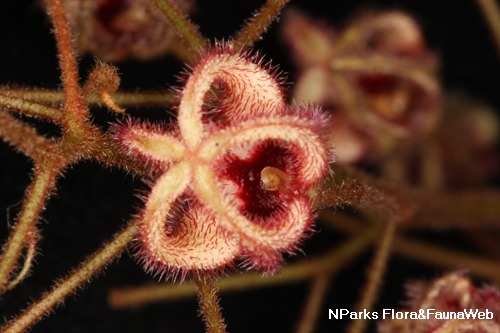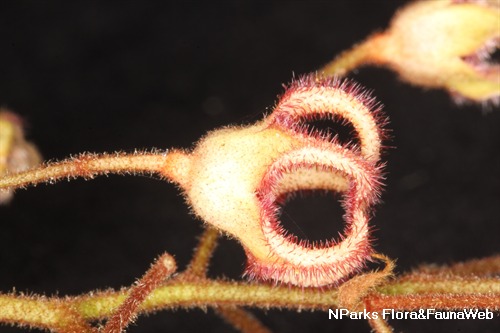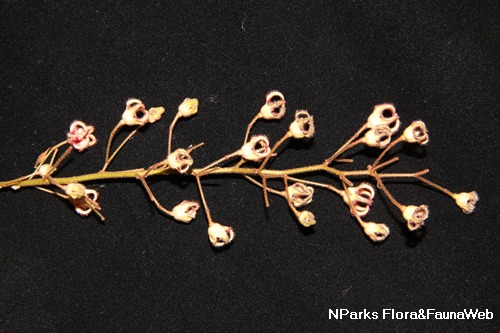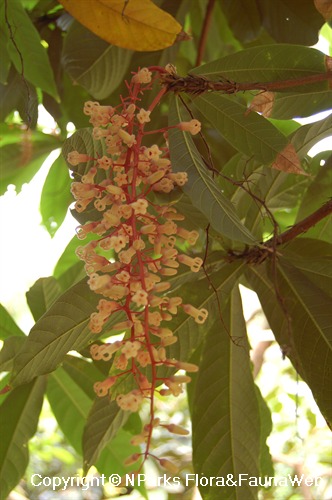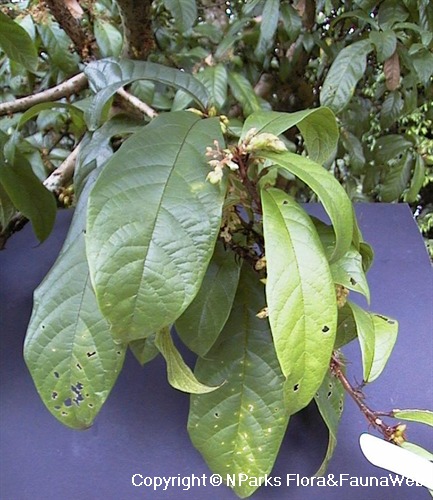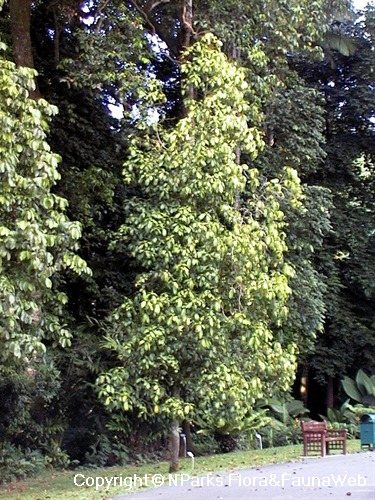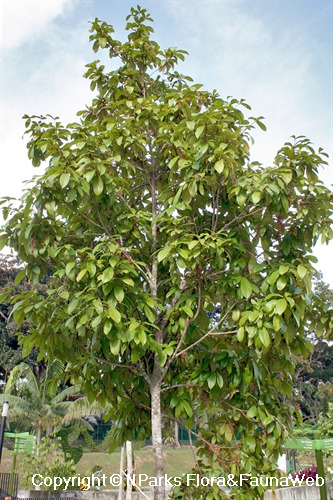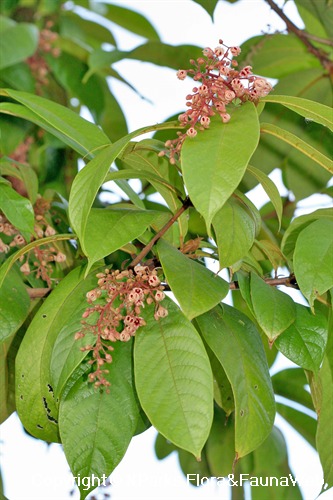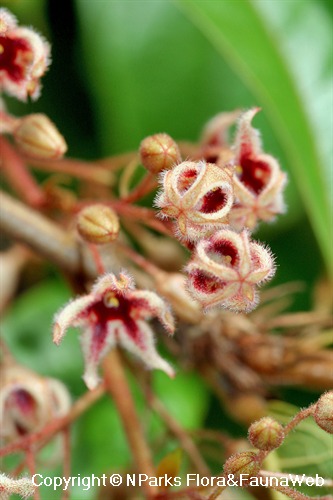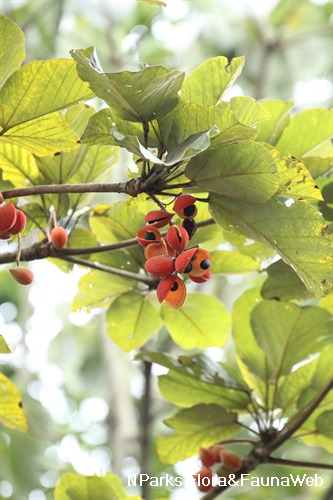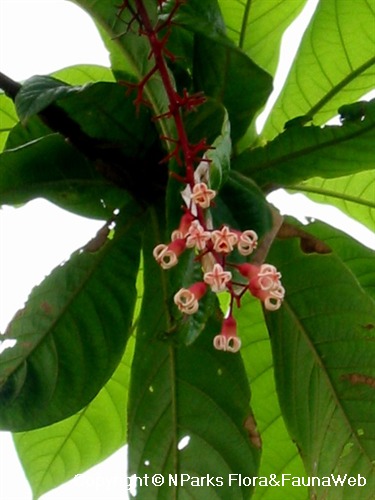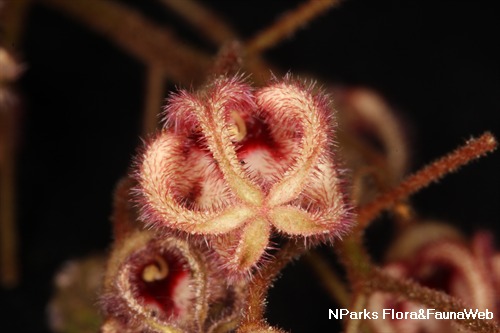
Back
Sterculia rubiginosa Vent.
| Family Name: | Malvaceae |
| Synonyms: | Sterculia angustifolia Jack (Wall), Sterculia brachycarpa Ridl., Sterculia cuneata R. Br., Sterculia elliptica Airy Shaw, Sterculia ferruginea R. Br., Sterculia jackiana Wall., Sterculia obovata Merr., Sterculia rostrata Ridl., Sterculia rufa Korth., Sterculia stipularis R. Br. |
| Common Name: | Rusty Sterculia, Kelumpang, Kelumpang Bukit, Kelumpang Gajah, Kayu Amplas, Bayur Betina, Dedamak Hitam, Pokok Sakhlat, Tangisan Burung, Unting-unting Besar |
Name
Classifications and Characteristics
| Plant Division | Angiosperms (Flowering Seed Plants) (Dicotyledon) |
|---|---|
| Plant Growth Form | Tree (Medium (16m-30m)) |
| Lifespan (in Singapore) | Perennial |
| Mode of Nutrition | Autotrophic |
| Plant Shape | Rounded, Broad / Mushroom / Hemispherical, Irregular |
| Maximum Height | 6 m to 20 m |
Biogeography
| Native Distribution | Thailand, Malaysia, Singapore, the Philippines, Brunei, and Indonesia |
|---|---|
| Native Habitat | Terrestrial (Primary Rainforest, Secondary Rainforest, Freshwater Swamp Forest) |
| Preferred Climate Zone | Tropical |
| Local Conservation Status | Native to Singapore (Vulnerable (VU)) |
Description and Ethnobotany
| Growth Form | It is a bushy tree that can grow up to 20 m tall. |
|---|---|
| Foliage | Its spirally arranged, stalked leaves have leaf blades that are papery to leathery, covered with hair below, lance-shaped, oval or egg-shaped, 7–27 cm by 3–13 cm, with 8–16 pairs of side veins and prominent venation underneath. |
| Flowers | The plant is monoecious, producing both unisexual and bisexual flowers. The flowers are green, yellow or white with red center, commonly covered with pink hairs, about 1.3 cm across, and occur on many-flowered flowering clusters (inflorescences) that are 6–30 cm long. |
| Fruit | The fruit is a follicle, which is a seed-pod that will split open along one side when dry. 3–5 follicles occur in a cluster. Each follicle is oblong, red or orange-brown, densely covered with fine hair outside, 3–10 cm long by 1.5–2.5 cm wide, and contains 2–6 seeds. Each seed is black, round or oval, and 10–18 by 6–8 mm. |
| Habitat | It grows in both primary and secondary forests, limestone hill forests and swamps, up to 1600 m altitude. It occurs locally in Bukit Timah Nature Reserve and Central Catchment Nature Reserve. |
| Associated Fauna | Its flowers are pollinated by insects. Its seeds are probably dispersed by birds. |
| Cultivation | It is propagated by seed. |
| Etymology | Latin stercus, dung, referring to the smell of flowers; Latin rubiginosa, rust-coloured |
| Ethnobotanical Uses | Timber & Products: It is harvested for timber for use in sheltered parts of houses. |
Landscaping Features
| Landscaping | It is suitable for planting along streetscapes, parks and gardens for its lush, rounded crown and ornamental flowers and fruits. |
|---|---|
| Desirable Plant Features | Ornamental Flowers, Ornamental Fruits, Ornamental Form |
| Landscape Uses | General, Suitable for Roadsides, Parks & Gardens, Small Gardens, Riverine, Pond / Lake / River, Marsh / Bog |
| Thematic Landscaping | Naturalistic Garden |
Fauna, Pollination and Dispersal
| Fauna Pollination Dispersal Associated Fauna | Bird-Attracting (Fruits) |
|---|---|
| Pollination Method(s) | Biotic (Fauna) |
| Seed or Spore Dispersal | Biotic (Fauna) |
Plant Care and Propagation
| Light Preference | Full Sun |
|---|---|
| Water Preference | Moderate Water |
| Plant Growth Rate | Moderate |
| Rootzone Tolerance | Moist Soils, Well-Drained Soils, Fertile Loamy Soils |
| Propagation Method | Seed |
Foliar
| Foliage Retention | Evergreen |
|---|---|
| Mature Foliage Colour(s) | Green |
| Mature Foliage Texture(s) | Papery, Leathery |
| Foliar Type | Simple / Unifoliate |
| Foliar Arrangement Along Stem | Alternate, Spiral |
| Foliar Attachment to Stem | Petiolate |
| Foliar Shape(s) | Non-Palm Foliage (Ovate, Oval, Lanceolate, Elliptical) |
| Foliar Venation | Pinnate / Net |
| Foliar Margin | Entire |
| Leaf Area Index (LAI) for Green Plot Ratio | 4.0 (Tree - Dense Canopy) |
Floral (Angiosperm)
| Flower & Plant Sexuality | Unisexual & Bisexual Flowers(Sub-dioecious) |
| Flower Colour(s) | Cream / Off-White, Pink, White |
|---|---|
| Flower Grouping | Cluster / Inflorescence |
| Flower Location | Axillary |
| Flower Symmetry | Radial |
| Flowering Habit | Polycarpic |
Fruit, Seed and Spore
| Mature Fruit Colour(s) | Red |
|---|---|
| Mature Fruit Texture(s) | Velvety / Furry / Tomentose |
| Fruit Classification | Simple Fruit |
| Fruit Type |
Image Repository
Others
| Master ID | 1849 |
|---|---|
| Species ID | 3142 |
| Flora Disclaimer | The information in this website has been compiled from reliable sources, such as reference works on medicinal plants. It is not a substitute for medical advice or treatment and NParks does not purport to provide any medical advice. Readers should always consult his/her physician before using or consuming a plant for medicinal purposes. |

